Understanding Fiber Internet Technology
Table of Contents
With all the recent media attention to fiber internet, are you wondering what the buzz is about?
In a nutshell, fiber internet is a huge leap forward from all previous types of internet connection.
You should know how fiber works and why it matters, so you can be an informed consumer. Understanding fiber internet technology is going to be crucial to your everyday life and to the whole world economy.
Fiber will allow internet activities we have never seen before. Those who don’t have fiber access may be left behind in another five years as the digital world expands.
In this article, we will explore the technology behind fiber internet and the benefits it offers. This article will help you understand everything about fiber internet and why it will be so important in the future. You’ll also be able to decide whether it’s better for you to switch to fiber now, or wait for the perfect time.
What is Fiber Internet?
Fiber internet is a type of internet connection that uses fiber optic cables to transmit data. These cables are made up of thin glass or plastic fibers that send data using light waves. Compared to traditional copper-based cables used in DSL and cable internet, fiber optic cables can transmit data over longer distances and at faster speeds.
Fiber internet technology has been around for several decades, but it wasn’t until recently that it became more widely available and affordable for consumers. Fiber was initially developed for use in the telecommunications industry. With the increasing demand for faster internet speeds, fiber internet has become a popular option for personal and commercial use.
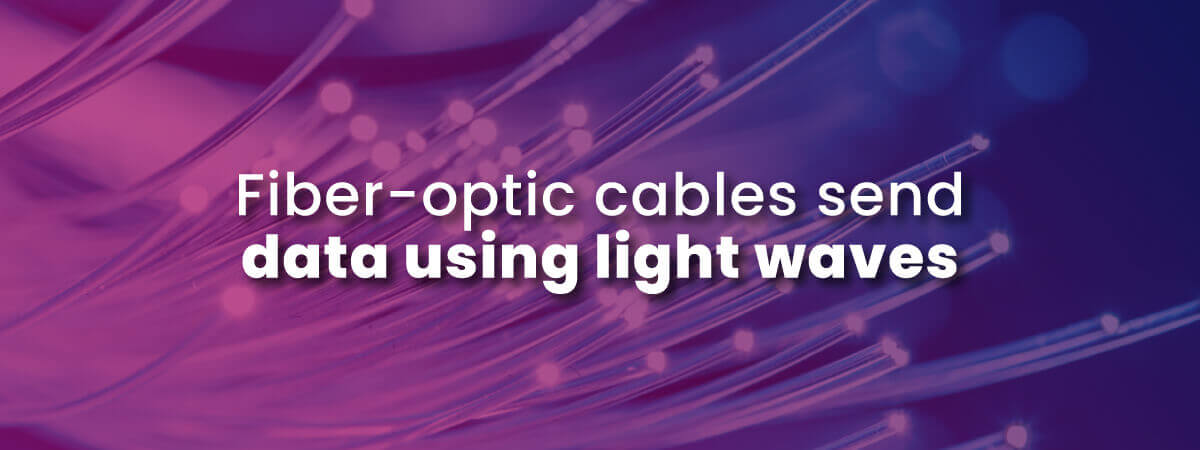
How Fiber Internet Works
To understand how fiber internet works, you need to know about the technology behind fiber-optic cables.
Types of fiber-optic cables
Fiber optic cables are made of thin glass or plastic fibers that are designed to transmit data using light waves. These cables come in different types, including single-mode and multi-mode cables. Single-mode cables are designed to transmit data over long distances, while multi-mode cables are designed for shorter distances.
How fiber-optic cables transmit data
When data is transmitted over fiber optic cables, it is first converted into digital signals. These signals are then transmitted as pulses of light through the fiber optic cables. The pulses of light travel through the cable by bouncing off the walls of the cable, which keeps the light within the cable and prevents it from escaping. The speed at which the light travels through the cable is determined by the refractive index of the fiber optic material.
Once the pulses of light reach their destination, they are converted back into digital signals. This conversion happens through a device called an optical receiver, which detects the light and converts it into electrical signals. The electrical signals are then sent to the device that requested the data, such as a computer or smartphone.
Fiber Internet Infrastructure
To provide fiber internet, internet service providers (ISPs) need to lay fiber-optic cables underground or on telephone poles. This infrastructure consists of the fiber-optic cables themselves as well as the necessary equipment for transmitting and receiving data over those cables. Once the infrastructure is in place, ISPs can provide fiber internet to homes and businesses in the area.
Fiber-optic transmitters and receivers
Fiber optic transmitters and receivers are key components of fiber internet technology. These devices are responsible for converting electrical signals into light signals that can be transmitted over fiber optic cables, and vice versa. The transmitter takes an electrical signal, converts it into a light signal, and sends it through the fiber optic cable. At the other end of the cable, the receiver takes the light signal and converts it back into an electrical signal.
Optical network terminals
An optical network terminal (ONT) is a device that is installed at the customer’s location to connect their devices to the fiber internet network. The ONT is usually installed on the side of the house or in the basement, where it serves as a bridge between the fiber optic cable coming into the house and the customer’s devices. The ONT is responsible for converting the light signals coming from the fiber optic cable into electrical signals that can be used by the customer’s devices.
Central office equipment
Central office equipment is used by ISPs to manage and distribute the fiber internet signal. This equipment includes routers, switches, and servers that help to route data between different networks and manage internet traffic. From a central office or data center, this equipment manages the flow of data between the ISP’s network and the rest of the internet.
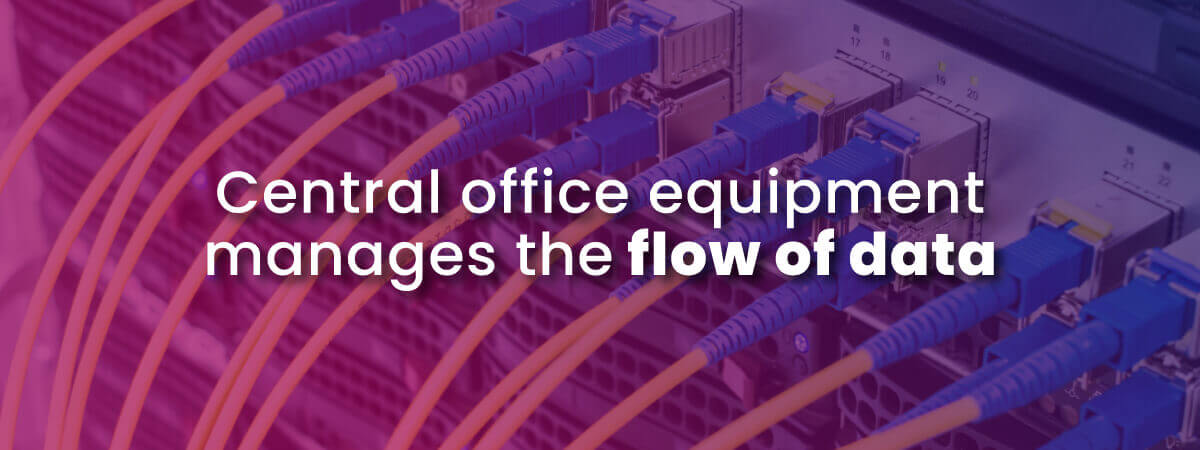
Differences Between Fiber Internet and Other Internet Connections
Fiber internet offers several advantages over other types of internet connections, such as DSL, cable, and satellite internet. Some of the key differences between fiber internet and other internet connections include internet speed, latency, reliability, and availability.
Fiber internet vs. DSL
DSL (Digital Subscriber Line) is a type of internet connection that uses traditional copper-based phone lines to transmit data. While DSL can offer faster speeds than dial-up internet, it is limited in terms of speed and reliability. DSL internet speeds are typically slower than fiber internet speeds. Compared to DSL, fiber internet delivers much faster speeds over longer distances, making it a more reliable option for high-speed internet.
Fiber internet vs. cable internet
Cable internet uses coaxial cables to transmit data. Cable is one of the most common types of internet connections in the US. Cable internet speeds are often slower than fiber internet speeds, especially for upload speeds. Fiber internet delivers faster and more symmetrical upload and download speeds, making it a better option for tasks such as video conferencing and online gaming. However, advances in cable technology now allow cable internet connections to approach the download speeds of mid-level fiber plans at around 1000 Mbps.
Fiber internet vs. satellite internet
Satellite internet uses a satellite dish to transmit and receive data. Satellite is a good option for rural areas where cable and fiber lines are not available. However, satellite internet is often slower and less reliable than other types of internet connections. Satellite service can be affected by weather and other environmental factors. Satellite internet also comes with data caps and higher latency, which can make it unsuitable for high-bandwidth tasks such as streaming HD video or online gaming. Fiber internet is exponentially faster and much more reliable than satellite internet.
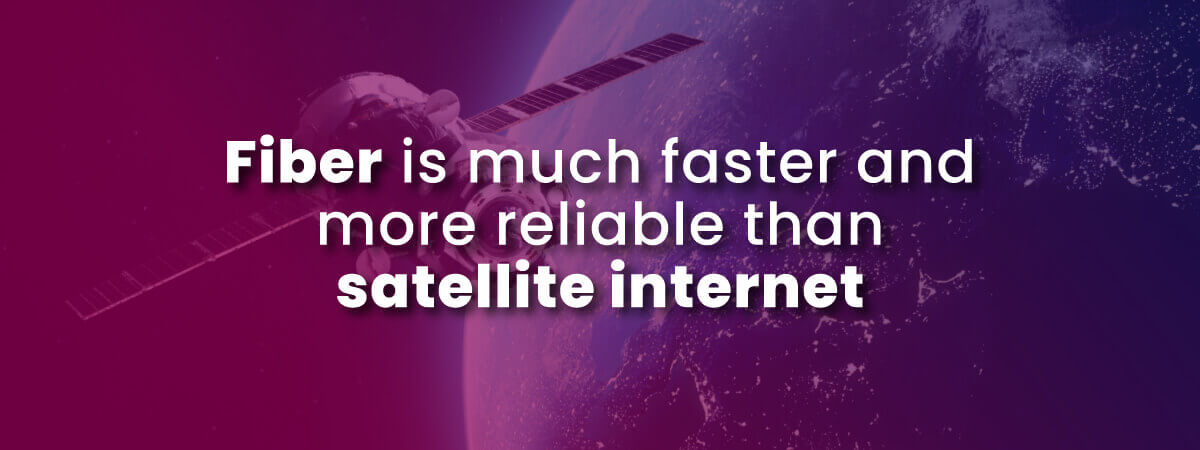
Advantages of Fiber Internet
Speed
Fiber internet can deliver much faster speeds than traditional copper-based connections, such as DSL and cable internet. Fiber-optic cables can transmit data at higher speeds over longer distances, making it possible to achieve gigabit speeds as high as 5000 Mbps (5 Gbps) or even higher.
Reliability
Fiber-optic cables are less susceptible to interference and signal degradation than copper-based cables. The resilience of fiber internet lines makes fiber more reliable than other types of internet connections. With fiber, you can expect fewer interruptions and more consistent speeds with fiber internet.
Symmetrical Upload and Download Speeds
Fiber is famous for its symmetrical upload and download speeds. You can upload data at the same speeds as you download data. This is a vast difference from the asymmetrical speeds of cable and DSL internet, which feature much slower upload speeds compared to their download speeds.
Low Latency
Latency refers to the time it takes for data to travel from one point to another. Fiber internet has lower latency than other types of internet connections, which can be especially important for online gaming, video conferencing, and other real-time applications.
Security
Fiber internet is also more secure than other types of internet connections, as fiber-optic cables are more difficult to tap into or intercept than traditional copper-based cables.

Disadvantages of Fiber Internet
Availability
Fiber internet is not available in all areas, and is especially scare in rural areas. ISPs have to make a significant investment in infrastructure to lay fiber optic-cables. Due to this cost, fiber internet may not yet be available in your specific neighborhood or building even if it is available in your area.
Cost to Consumer
Top fiber internet plans can be more expensive than other types of internet connections such as DSL or cable internet. However, most first-tier fiber plans are now approximately equal to the cost of older technologies.
Installation
Installation of fiber internet can be more complex and time-consuming than other types of internet connections. Fiber optic cables need to be run directly to your home or business, which can require drilling and other construction work.
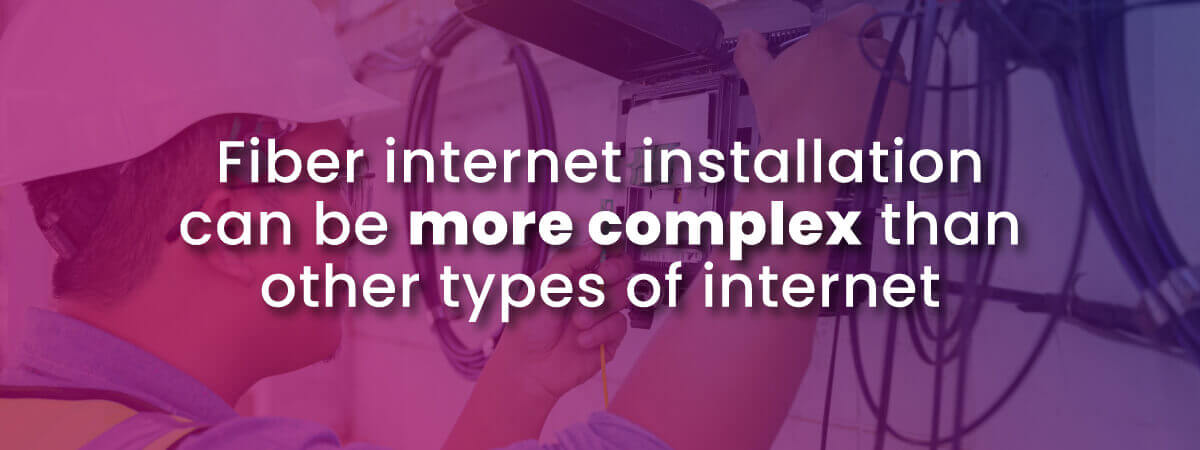
Factors to Consider Before Choosing Fiber Internet
You should consider several factors before you switch to fiber.You’ll want to look into the availability of fiber internet in your area, your bandwidth needs, your budget, the installation process, and the quality of customer support provided by your internet service provider (ISP).
Availability
The first factor to consider is whether fiber internet is available in your area. You can check with your local ISPs to see if they offer fiber internet in your area, and what speeds and pricing options are available.
Bandwidth needs
Know your household bandwidth needs. If you primarily use the internet for tasks such as browsing the web and checking email, you may not need the fastest internet speeds available. However, if you regularly stream video, play online games, or work from home, you may benefit from the faster speeds and lower latency that fiber internet provides.
Budget
The fastest fiber internet plans can be more expensive than other types of internet connections, so it’s important to consider your budget. You should compare the pricing and speed options offered by different ISPs to find the best value.
Installation process
The installation process for fiber internet is more complex than other types of internet connections. This may involve drilling holes in your walls or running fiber optic cables underground. Before signing up for fiber internet, ffind out what the installation process involves so you can pick a good date.
Customer support
Investigate the quality of customer support provided by your ISP. If you have any issues with your internet connection, you want to be sure that your ISP will be responsive and helpful in resolving them.
Fiber Internet and Internet of Things (IoT)
The Internet of Things (IoT) refers to the growing network of internet-connected devices that are able to communicate and exchange data with one another. Fiber internet plays an important role in enabling IoT.
How fiber internet enables IoT
Fiber internet supports IoT by providing faster and more reliable internet speeds. This is essential for devices that require real-time data exchange, such as smart home devices, security systems, and industrial sensors.
Advantages of fiber internet for IoT
Fiber internet offers several advantages for IoT devices, including faster speeds, lower latency, and higher reliability. With fiber, IoT devices can communicate and exchange data more efficiently, which leads to improved functionality and productivity.
Examples of IoT devices that use fiber internet
Many types of IoT devices use fiber internet, including smart home devices such as thermostats, security cameras, and voice assistants. Other examples include industrial sensors, traffic monitoring systems, and medical devices.

Fiber Internet and 5G Technology
5G technology refers to the fifth generation of wireless networks, which offer faster speeds and lower latency than previous generations. Fiber internet and 5G technology work together to provide even faster and more reliable internet speeds for consumers and businesses.
How fiber internet and 5G work together
Fiber internet provides the backbone for 5G networks, as it offers the necessary infrastructure for transmitting and receiving data. In turn, 5G technology provides a wireless connection for devices that is faster and more reliable than previous generations.
Advantages of fiber internet and 5G for consumers and businesses
The combination of fiber internet and 5G technology offers several advantages for consumers, including faster download and upload speeds, lower latency, and improved reliability. This can lead to improved streaming quality, faster downloads, and better online gaming experiences.
For businesses, fiber internet and 5G technology offer several advantages as well. These include faster and more reliable internet speeds, which can lead to improved productivity and efficiency. Additionally, 5G technology can enable new applications and services, such as real-time virtual reality experiences and remote machine control.
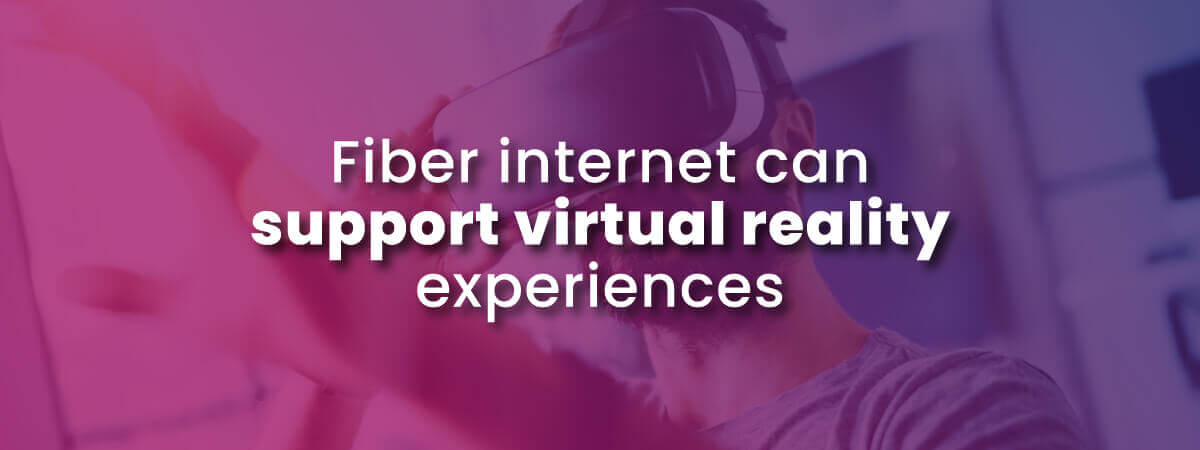
Future of Fiber Internet
Fiber internet has already transformed the way we connect to the internet, but more change is coming soon. Fiber-optic cable technology will continue to get faster, fiber internet infrastructure will expand, and increased adoption of fiber internet will support further innovation.
Advances in fiber-optic cable technology
Advances in fiber-optic cable technology are making fiber internet even faster and more reliable. Researchers are exploring new materials for fiber optic cables that could enable even faster speeds and longer distances.
Expansion of fiber internet infrastructure
The expansion of fiber internet infrastructure is also an important trend to watch. Many internet service providers are investing in fiber internet to offer faster speeds and more reliable connections to their customers. This investment is likely to continue with massive government support, which will make fiber internet much more widely available in the next decade.
Adoption of fiber internet by consumers and businesses
As fiber internet becomes more widely available and more affordable, more consumers and businesses will adopt this technology. This adoption will lead to new innovations and applications for fiber internet.
Fiber Internet and the Environment
Fiber internet offers several energy-efficient and environmentally friendly advantages over other types of internet connections.
Energy efficiency
Fiber internet is more energy-efficient than other types of internet connections, such as cable and DSL internet. Fiber optic cables require less energy to transmit data over longer distances, which can lead to significant energy savings over time.
Reduced carbon footprint
Fiber internet also has a reduced carbon footprint compared to other types of internet connections. Fiber optic cables are made from materials that are more sustainable and environmentally friendly than traditional copper-based cables.
Impact on the environment
Overall, fiber internet has a positive impact on the environment by reducing energy consumption, reducing carbon emissions, and promoting the use of more sustainable materials. As more consumers and businesses adopt fiber internet, these environmental benefits will become even more significant.
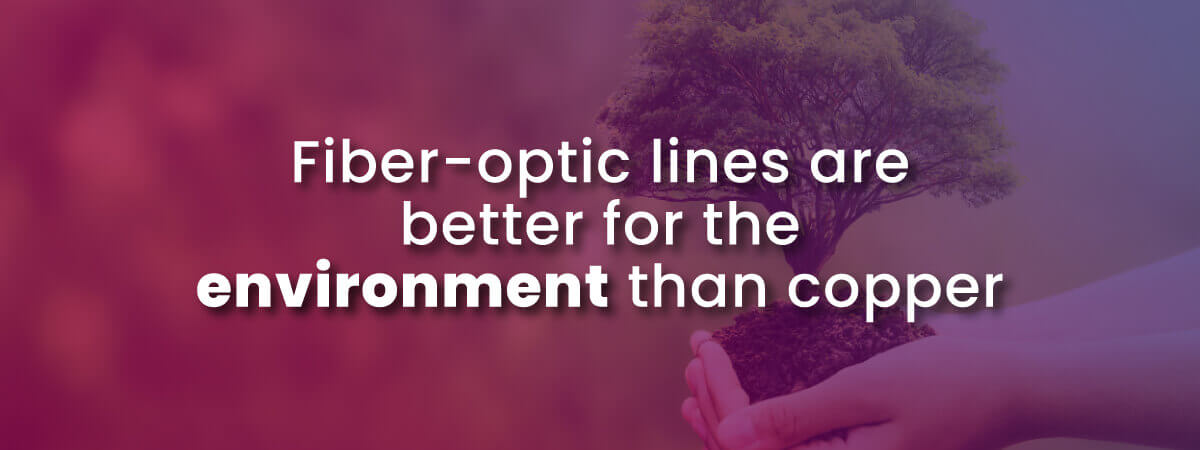
Fiber for the Future: Unlimited Potential
The future potential of fiber internet is so vast we can’t even foresee where it will be in a decade. With advances in fiber optic cable technology, the expansion of fiber internet infrastructure, and increased adoption by consumers and businesses, fiber internet is poised to become even faster, more reliable, and more widely available in the coming years.
Fiber internet’s ability to transmit data at higher speeds and lower latency makes it ideal for supporting emerging technologies such as virtual reality, augmented reality, and the Internet of Things. These technologies require real-time data transmission, which can be challenging for other types of internet connections. Fiber internet’s symmetrical upload and download speeds also make it well-suited for cloud computing, which allows users to access data and applications remotely.
Additionally, fiber internet’s energy-efficient and environmentally friendly advantages make it an increasingly important technology for our connected world. As fiber internet continues to evolve and expand, it will play an even greater role in shaping the future of the internet and the way we connect to it.
FAQs: Fiber Internet and You
How much does fiber internet cost?
The cost of fiber internet can vary depending on a variety of factors, including location, speed, and provider. On average, prices for fiber internet can range from around $40 to $100 or more per month, depending on the speed and features included. Look for any hidden fees: some providers have equipment charges or cancellation fees. Brightspeed Fiber plans are simple and transparent.
How does fiber internet installation work?
Fiber internet installation typically involves running fiber optic cables from a nearby central office to your home or business. This may involve drilling holes in walls, running cables underground, or other installation methods depending on the specific setup. Professional technicians will handle the installation process. You will need to schedule an appointment when you are home to ensure that the installation is completed correctly.
Will fiber fix my slow internet and dropped internet connections?
Fiber internet will solve many of the typical problems related to slow internet, but not all of them, especially if your issue is with your home Wi-Fi. See our full guide on how to diagnose why your internet keeps going out.
Why is fiber internet expanding so rapidly?
Fiber internet is expanding rapidly due to the increasing demand for faster and more reliable internet speeds, as well as the investments being made by internet service providers (ISPs) in fiber optic infrastructure. The federal government is also allocating massive funding for broadband expansion. Brightspeed has a special corporate mission to expand fiber in underserved areas. Read more here about whether fiber is available in your area or coming soon.

